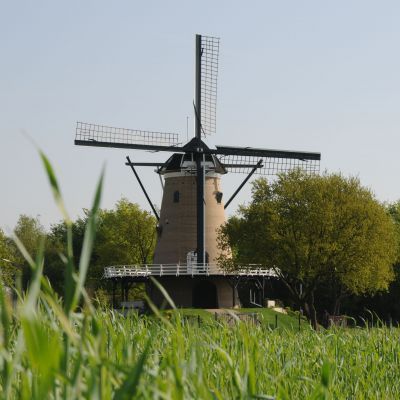Flour mill De Windhond

As from 1774 De Windhond was owned by the family Smits, who operated the mill during five generations. In 1921 the last owner is someone with the appropriate name Mulder, the old dutch name for miller. He is the son of the miller at De Vlijt. In 1977 the foundation De Windhond was started with the aim to rebuilt De Windhond. In 2008 the rebuilt mill was finalised and ready to start milling, 271 years after the construction of the first Windhond, which was built from stone.
Underneath the mill is the Miller's Room located. This room can be booked for parties, meetings, etc. while catering can be ordered from three local caterers: Catering Centraal, Eetvilla van den Brink and Brasserie de Soester Duinen.
Web site: www.molenaarskamer.nl
E-mail: info@molenaarskamer.nl
Though you will find mills in several countries, in the Netherlands the most species were developed, whereby the highest perfection was realised. Mills for centuries determined the Dutch landscape and contributed to the large prosperity. Nearly all the polders have been dryed with the help of watermills. But also the industry was dependant on windforce and mills sawed wood for ships, grinded raw materials for paint, the paper production was dependant on mills and of course mills grinded the corn for people and animals.
At the beginning of last century steam engines, internal combustion engines and electrical propulsion rendered mills superfluous. In the last century there were in Soest two mills: De Windhond en De Vlijt, both were corn mills. During the thirties these mills were closed and De Windhond was demolished. Suitable parts were used for the building of houses and farms. In the meantime De Windhond is rebuilt and so it is possible to see how in the early days, with the then available means, wind force was used to grind corn..
De Windhond anno 2008 is rebuilt with the knowledge we have from the former Windhond. It is not known how many grind stones the former Windhond has had, probably there were two or three stone couples.
The history of the Windhond starts in the fifteenth century. A wooden standard mill was located at the Soester Eng. Around 300 years later in 1737 Gerrit Volkertszoon Varenkamp realised the construction of a round, built from stone, balcony mill to replace the old standard mill. The result was a big mill 14,5 meter high, which was later called “the stone giant at the Zoester Eng”.
In case you wish to have aditonal information, please contact us via Contact.
De Windhond
Molenweg 303764 TA, Soest
info@windhond.nl
| Maandag | Gesloten |
| Dinsdag | Gesloten |
| Woensdag | 12:00 - 16:00 |
| Donderdag | Gesloten |
| Vrijdag | Gesloten |
| Zaterdag | 12:00 - 16:00 |
| Zondag | 12:00 - 16:00 |





